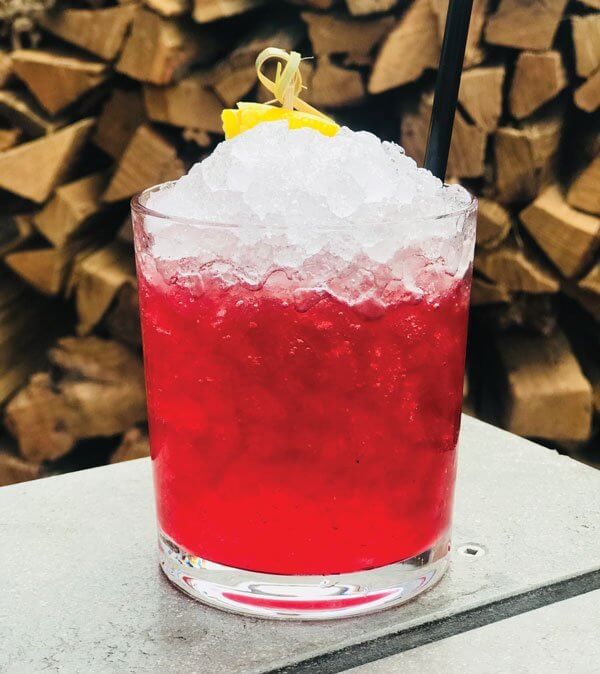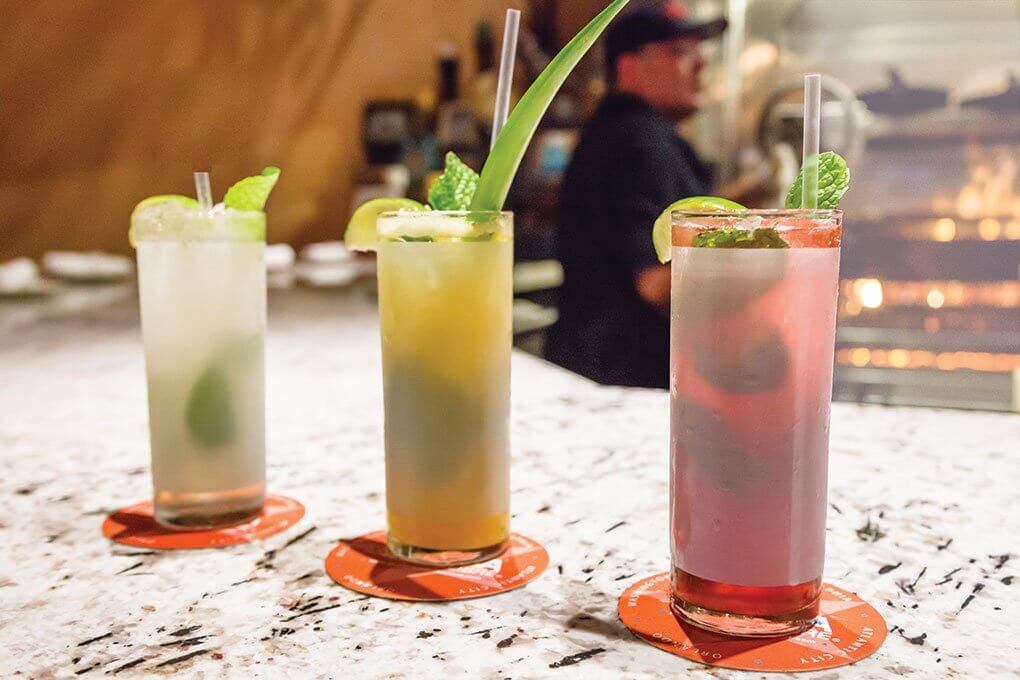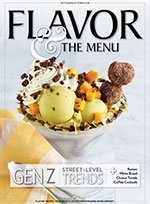While craft cocktails may have enjoyed most of the buzz in the last few years, nonalcoholic options are proving they’ve got game, thanks to serious flavor-driven menu development. The demand for menu items that boast craftsmanship and creativity has boosted innovation in this category.
With today’s options showcasing freshness, clever flavor combinations and originality, all types of guests are responding favorably—those grown-ups not looking for a cocktail or glass of wine as well as younger consumers, who value the attributes fueling the nonalcoholic beverage trend.
Innovation in nonalcoholic beverages has no single origin. On the one hand, operators are leveraging back-of-house skills to create one-of-a-kind beverages using fresh ingredients in unexpected combinations. These efforts are born out of the broader housemade or house- crafted trend.
Certainly, changing expectations around health and wellness have driven the growth of beverages that enjoy a health halo. And, without a doubt, the proliferation of world cuisines in the U.S. food industry influences flavors and formats in drinks as well.
Nonalcoholic beverages offer limitless opportunities for innovation. The question is how to select the right mix that best fits the concept and patrons. Here are 10 areas around which to innovate.
 ACORN
ACORN At Acorn in Denver, the Southeast Visions demonstrates modern complexity with coconut water, lemon, aromatic bitters and blackberry tea.
CROSSING BASES
The best ingredients are those that work across multiple categories and menu parts. Hard- working ingredients create better value back-of-house and leverage popular elements in new ways. Multitasking bar bases include tonics, shrubs and syrups.
- Grapefruit: Fresh grapefruit juice, lemon, housemade ginger syrup, orange bitters
—Connie and Ted’s, West Hollywood, Calif. - Dakota Soda: Housemade raspberry shrub, soda water
—Dakota Jazz Club & Restaurant, Minneapolis
Using bases and components typical of cocktails is smart from the operator perspective. From the consumer perspective, these elements help create nonalcoholic beverages that maintain an adult sensibility rather than offering kid-oriented compromises.
VEG-CENTRIC
Vegetables are all over the menu, and the nonalcoholic beverage category is no exception. While tomato juice has been around for a while, this new veg-centric innovation is something quite di erent, maximizing the flavor-focused trend while capitalizing on the current fascination with produce.
- Green Ginger Limeade: Green grapes, spinach, ginger and lime
—Greens and Proteins, multiple locations in Nevada - HeartBeet Shake: Beets, orange juice, celery, cucumber, blueberries, agave nectar
—Boloco, based in Hanover, N.H.
Vegetables have an incredible impact on the vibrancy and appeal of beverages. The colors that can be achieved range from subtle to shocking, and flavors can cover the spectrum from muted to complex, sweet to savory. Of course, adding vegetables immediately creates a health halo and presents a fresh adult option.
SPIRITLESS SPIRIT
Seedlip—a distilled nonalcoholic spirit—is new on the scene. Based on historical methods of using copper stills to distill herbal remedies, the spirit comes in di erent combinations of herbal ingredients and will likely inspire other brands to follow suit.
- The Garden Sour: Seedlip Garden 108, aquafaba, simple syrup, celery, apple, lemon, nigella seeds
—The Fat Radish, New York - Stowe Spritz: Seedlip Garden 108, strawberries, basil leaves, simple syrup, craft tonic
—Vetri Family, Philadelphia
Seedlip takes the sensibility of fresh ingredient-based tinctures, using classic techniques from historical manuals, but brings the flavors into the 21st century. This booze-free spirit can help create grown-up mocktails that don’t feel like a compromise in complexity or coolness. Though still relatively uncommon here, this British nonalcoholic ingredient is bound to grow and be followed closely by other iterations.
FUNCTIONAL BENEFITS
Modern health and wellness objectives focus on the functional, nutrient-rich benefits of ingredients, and nonalcoholic beverages are one of the most straightforward carriers of these traits, with no shortage of health-giving ingredients at the ready.
- Blackberry Chia Hibiscus Shrub with hand-squeezed citrus, soda water
—Tres Tempe, Tempe, Ariz. - Vibrant Matcha Latte: Matcha, raw honey, sprouted almond or coconut milk
—Café Gratitude, multiple locations in California
Functional health benefits are the new frontier of healthy dining. Though patrons may not understand all the science behind the ingredients, their desire for beverages that help them live longer/healthier, and enjoy life more needs no scientific background. And the potential health benefits area as wide ranging as the ingredients that can deliver them, providing endless innovation potential.
TEXTURES
Textures, from viscous or rich to light and airy, are as much at the heart of careful nonalcoholic beverage innovation as flavor and appearance. They need to be as carefully considered as other elements in the nonalcoholic beverage development process.
- Vanilla Mint Lemonade: Vanilla, muddled mint and sparkling housemade lemonade
—Tomatina, multiple locations in California - Strawberry Balsamic Soda: Puréed strawberries, touch of balsamic, strawberry syrup
—Pastini, multiple locations in Oregon
Texture has an increasing role in beverage development today. Consider how the various elements contribute to the texture and how that can be further influenced by preparation techniques. Think e ervescence, foams, muddles, chipped ice, or crystallized rimming agents.
BITTERS
Bitters is one of the fastest-growing flavoring agents on the bar menu, so the inclusion of nonalcoholic versions in innovative booze-less beverages is a no-brainer. As an on-trend bar ingredient, bitters immediately sets a nonalcoholic beverage on another level.
- Scarlet Wave: Fresh limeade, “Jamaica flower” tea, Peychaud’s bitters
—Topolobampo, Chicago - Southeast Visions: Coconut water, lemon, aromatic bitters, blackberry tea
—Acorn, Denver
Whether a beverage is positioned as a mocktail or simply a no-alcohol option, bitters can change the flavor, appearance and complexity of a beverage and help mimic the cocktail experience. Making those beverages in-house creates an even more distinct crafted- beverage option.
COLD BREW
Whether a beverage is positioned as a mocktail or simply a no-alcohol option, bitters can change the flavor, appearance and complexity of a beverage and help mimic the cocktail experience. Making those beverages in-house creates an even more distinct crafted- beverage option.
- Black Cherry Cold Brew Tea: Cold brew tea blended with black cherry puree
—The Coffee Bean & Tea Leaf, based in Los Angeles - Cold Brew Lemonade: Cold brew coffee + sparkling lemonade
—Clarity Coffee, Oklahoma City
The cold-brew technique results in a smoother flavor that blends well with a wider array of flavors. Plus, its trend-forward coolness elevates the appeal.
RIMS & GARNISHES
In the nonalcoholic realm, concepts o ering “extreme” shakes or “loaded” Bloody Marys have raised the bar on garnishes—perhaps beyond what most operators and patrons need. But they prove the point that creativity is limitless and expectations are high.
No-Jito: Guarapo, fresh lime juice, mint and a splash of soda, served with a slice of cucumber spiraled in the glass
—Cuba Libre, Washington, D.C.
Sea Cucumber: Salted cucumber juice, citrus, simple syrup, water with dehydrated salted cucumber juice as a chip to top
—Providence, Los Angeles
Creating garnishes that steal the show and upgrade the beverage experience can help develop a truly competitive position. Rethinking what, and how, ingredients are used in and on the glass is shifting a beverage’s impact, literally bringing Instagrammable appeal the moment the drink hits the table.
PLANT-BASED MILKS & CREAMS
Though soy, coconut and almond are the most common non-dairy ingredients, new alternative milks and creams have become more prevalent—from peanut milk to cashew cream—paving the way for endless innovation.
- Muscat Oolong: Premium tea with choice of toppings, sweetness level and type of milk, including almond, soy or oat milk
—Boba Guys, San Francisco - Oat Milk Latte
—Beatrix, Chicago
While non-dairy milks and creams were originally aimed at satisfying vegetarian and vegan consumers, their applicability has broadened well beyond the intended purpose. Original alternative milks—soy, coconut and almond—have the greatest familiarity and accessibility, but emerging non-dairy versions such as cashew, macadamia, peanut, pecan and oat o er new flavors as well as functionality.











